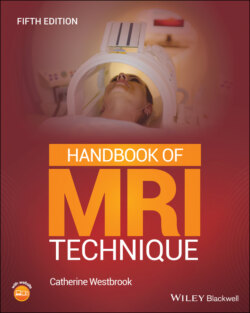Читать книгу Handbook of MRI Technique - Catherine Westbrook - Страница 36
CONCLUSION
ОглавлениеThe variety of protocol parameters used in MRI is often bewildering, but their importance is undisputed, especially in determining image quality. A good working knowledge of these parameters and how they interrelate is necessary to ensure an optimum examination. Table 2.2 summarizes these trade‐offs. The choice of pulse sequence is also important in determining image contrast and these are discussed in the next section.
Table 2.2 Parameters and their trade‐offs.
Source: Catherine Westbrook and John Talbot, MRI in Practice, 5th ed., John Wiley & Sons, 2019.
| To optimize image | Adjusted parameter | Consequence |
|---|---|---|
| Maximize SNR | ↑NSA | ↑Scan time |
| ↓Image matrix (fixed FOV) | ↓Scan time (pMatrix) | |
| — | ↓Resolution | |
| ↑Slice thickness | ↓Resolution | |
| ↓Receive bandwidh | ↑Minimum TE | |
| — | ↑Chemical shift | |
| ↑FOV (fixed matrix) | ↓Resolution | |
| ↑TR | ↓T1 contrast (during incomplete recovery) | |
| — | ↑Number of slices | |
| ↓TE | ↓T2 contrast | |
| Maximize resolution (assuming a square FOV) | ↓Slice thickness | ↓SNR |
| ↑Image matrix (fixed FOV) | ↓SNR | |
| — | ↑Scan time (pMatrix) | |
| ↓FOV (fixed matrix) | ↓SNR | |
| Minimize scan time | ↓TR | ↑T1 contrast (during incomplete recovery) |
| — | ↓SNR (until complete recovery) | |
| — | ↓Number of slices | |
| ↓Phase matrix (fixed FOV) | ↓Resolution | |
| — | ↑SNR | |
| ↓NSA | ↓SNR | |
| ↑Movement artifact | ||
| ↓Slice number in volume imaging | ↓SNR |
